Clam Girl's Second Swim
Previously published in SCA September 2018
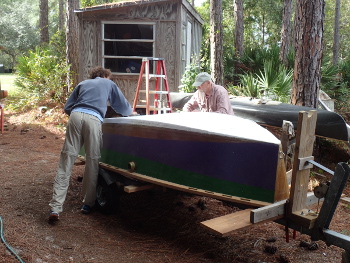 October 22, 2018. Bill Ling helped Simon Lewandowski and me slowly slide a four and a half foot hot wire along guides
the full length of Clam Girl. The wire glided through polystyrene foam we had glued to Clam Girl's bottom the day before,
to increase her rocker.
October 22, 2018. Bill Ling helped Simon Lewandowski and me slowly slide a four and a half foot hot wire along guides
the full length of Clam Girl. The wire glided through polystyrene foam we had glued to Clam Girl's bottom the day before,
to increase her rocker.
Last May, during the Cedar Key boat meet, we did not sail Clam Girl, as hoped. But, Simon, Bill & I did align and epoxy tack Simon's female leeboard cones into the hull.
The cones needed to be hardened in, but the teak gunwales had to come first, because they could change the shape of the hull, possibly misaligning the cones. In any case, the teak work couldn't be rushed. Six10 epoxy's static mixer tip let me work solo in near 90s F with mid 70s dew points.
Late May's rains didn't help. I moved her rig to the upper, screened porch, to make fittings, and pore over scores of hooks and hoops, cleats, and styles of line.
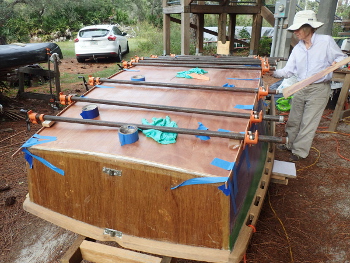 June often brought lightning, too, with May's rain pattern. Between squalls I roughed out the step and PVC conduit mast
tube, setting and striking the fifteen foot mast outside the concrete deck, eleven feet up.
June often brought lightning, too, with May's rain pattern. Between squalls I roughed out the step and PVC conduit mast
tube, setting and striking the fifteen foot mast outside the concrete deck, eleven feet up.
More rain. Back under the concrete. Karen painted the port side - the starboard side is still bare. I finished the mast step and tube, partner-deck, and below seat leeboard brace.
In July the clouds left and summer's heat blazed back - highs of low 90s, upper 70s dew points, including a day with a dew point of 82.
The first week of September, a gust of rain came so heavily under the concrete deck, the epoxy batch I'd just mixed went straight into the freezer. The next day in only slanting rain, the glue thawed in a few minutes and the step structure was finally stuck in.
September 10th, Simon drove up from St Pete, bringing his male carbon cones that bolt to the leeboards.
We verified the hull's cones' alignment. While he fitted the male cones to a pair of rough boards, I carbon taped the hull's cones to the seat brace structure.
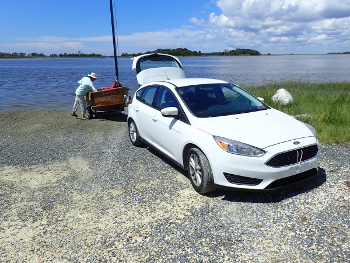 On the 13th we plopped her into the Gulf at the Shell Mound in the Lower Suwannee NWR. Mostly sunny, upper 80s, thunder
heads to the east, southwesterly four to eight knots.
On the 13th we plopped her into the Gulf at the Shell Mound in the Lower Suwannee NWR. Mostly sunny, upper 80s, thunder
heads to the east, southwesterly four to eight knots.
Within fifty yards of the launch Simon and I grinned as we ran over oysters with the leeboards clunking and pivoting up. The aluminum rudder blade clanked and banged its sweet tune. Simon turned the leeboards' handles and the boards went down as we'd imagined, although not yet as smoothly as they should. We tacked away, smiling with the comforting glee of most expectations met.
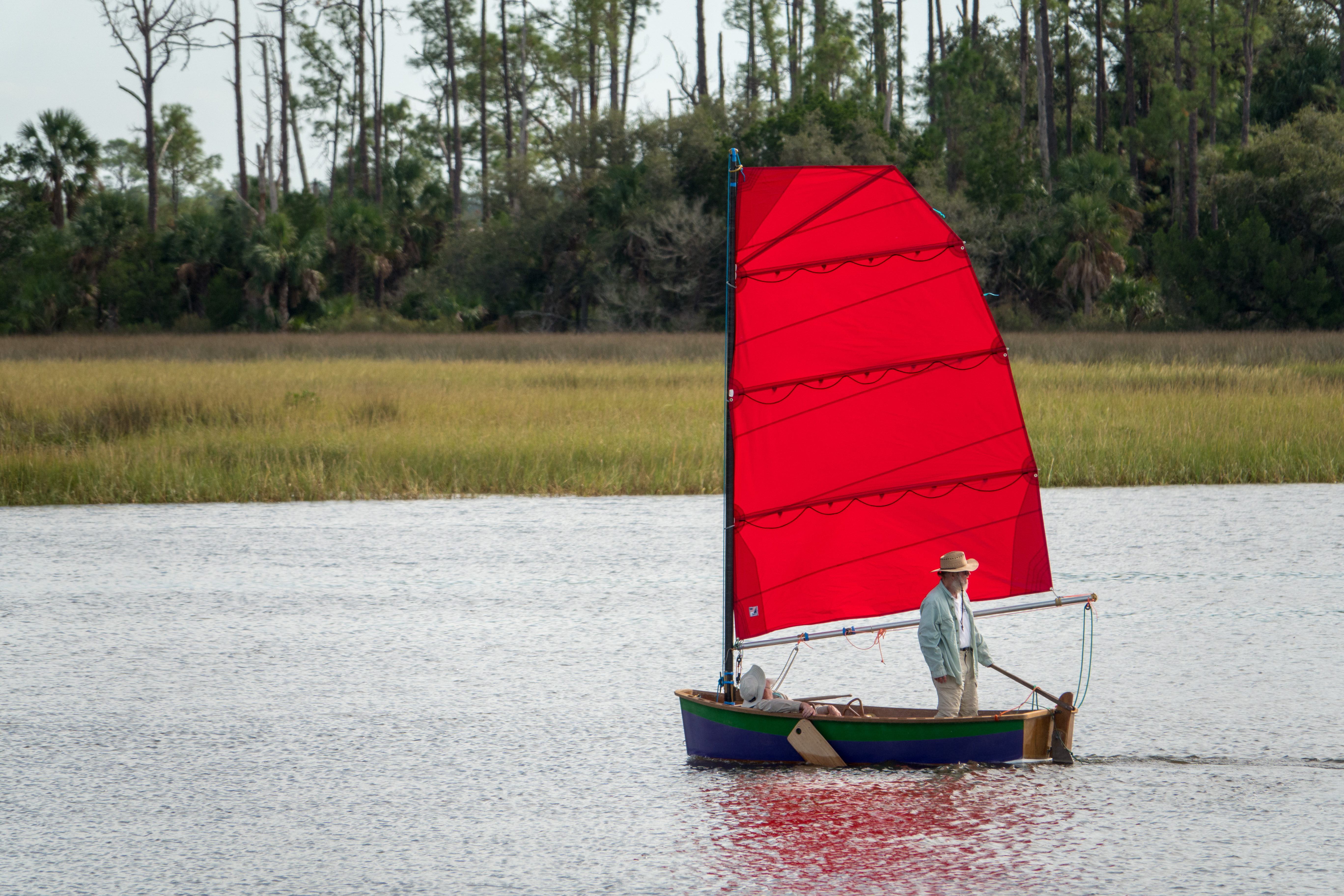 Another twenty yards she accelerated with the breeze. I heard forward a soft "white noise" of rushing water, and my
mind exploded. 'No! Where's the slapping rattle!?'
Another twenty yards she accelerated with the breeze. I heard forward a soft "white noise" of rushing water, and my
mind exploded. 'No! Where's the slapping rattle!?'
After the first long tack, Simon hung out to starboard to look. The bow knuckle was submerged a couple inches.
Displacement with us was about 470 pounds. Her design water line of 450 pounds had nagged me a little, but not enough.
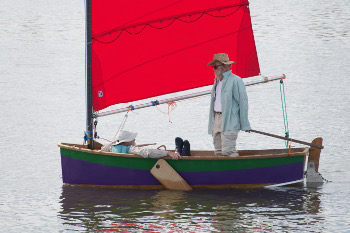 In the excitement a year ago of watching JF Bedard and Simon work their magic software, I'd meant to re-check
displacement compared to my lofting and the model, but I didn't.
In the excitement a year ago of watching JF Bedard and Simon work their magic software, I'd meant to re-check
displacement compared to my lofting and the model, but I didn't.
A couple months later, in February, when Karen and I were starting to zip tie the prototype together, a mistake of mine lost another half inch of rocker. The inside corners of bottom and sides should have met, rather than the bottom fitting within the sides.
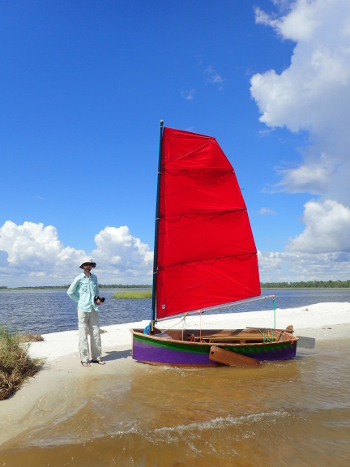 As we sailed I asked Simon about adding a false bottom. In a few minutes he explained the hot wire method of cutting
foam for small airplane wings.
As we sailed I asked Simon about adding a false bottom. In a few minutes he explained the hot wire method of cutting
foam for small airplane wings.
Besides the egregious displacement, what's been learned? The fullness of the chine forward in plan view, which looked right when I drew her, when I modeled her, and from inside the boat, had looked too full from the outside on the prototype. Zero problem, so far. Its added buoyancy helps, too, when standing at the mast, easily overcoming the disadvantages of extra wetted surface, or a possible tendency to "gripe," to turn into the wind with strong weather helm.
At full sail the tack was too low, so I added nine inches to the masthead. I adjusted mast and boom fittings, and replaced jam cleats with three of Harken's versatile cams.
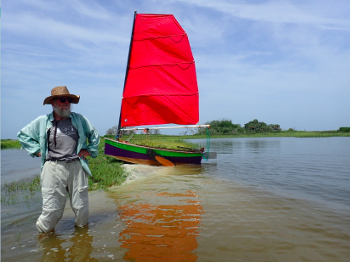 Misgivings? Ignoring at least two maxims. 'Do it right the 1st time.' 'Penny wise & pound foolish,' whether time or
money.
Misgivings? Ignoring at least two maxims. 'Do it right the 1st time.' 'Penny wise & pound foolish,' whether time or
money.
October 22nd at the Shell mound, Bill, Simon and I carefully lifted her off the trailer, carried her into the water and gently set her into the Gulf.
"Slap, slap, rattle, slap." With Bill and me, displacement was 520 pounds. Her stern wake was clean, too. Yippee skippy!
~HH